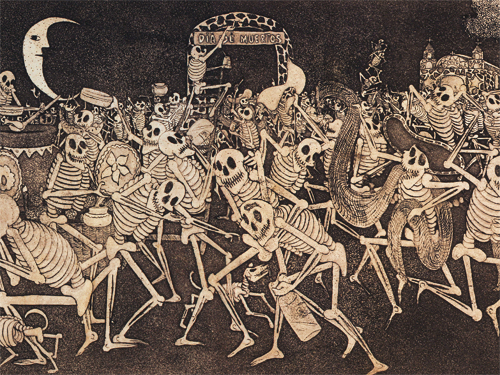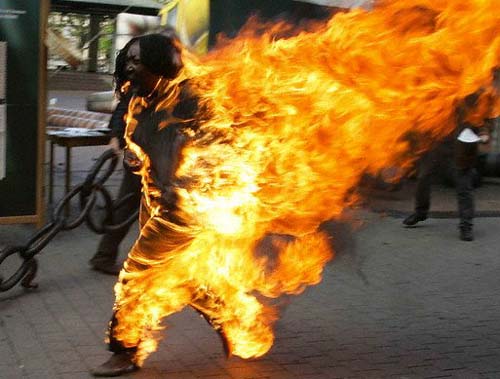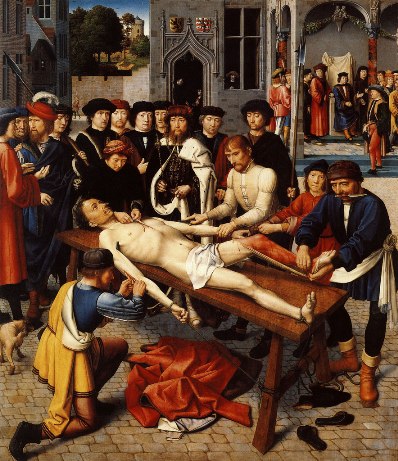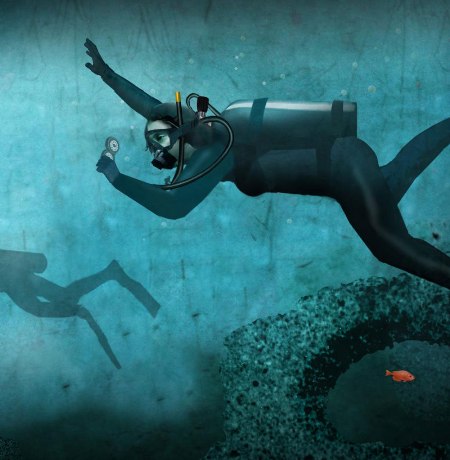Death comes in many different faces and can choose anyone anytime
Death comes in different faces and can choose anyone. Naturally, peple die because of old age; however, not everyone is fortunate enough to die of natural causes. Some unfortunate souls encounter the Grim Reaper in his most menacing form, stealing their last breaths in some of the worst ways imaginable. If you are a fan of snuff films, torture movies or gory videos, then you probably have an idea of some of the worst ways to die – however, not all forms of death involve torture or mutilation. The following are some of the different forms of death.
1. Burning or Immolation
Burning alive is one of the few deaths that we actually do have a preview of. Burn victims describe their pain as sheer agony. A living victim of a fire will suffer first, second, or third degree burns – the slightest of which causes pain, redness, and swelling, and the more severe of which extends into the deepest muscle tissues, causing the skin to blister and eventually char. The pain is excruciating and it continues until the internal organs begin to liquefy, death finally occurring either by the layers of your body literally burning away bit by bit, or your brain shutting the body down because it can no longer function in the intense heat.
If a fire is large enough, lucky victims actually die of carbon monoxide poisoning before the flames ever reach them. So, fingers crossed for carbon monoxide! However, if the fire was small, the victim usually died from stroke, shock, or loss of blood plasma. As a form of execution, burning was used as a penalty for those guilty of witchcraft, heresy and treason. To minimize the pain of the condemned, family members would bring additional straw, called faggots, and firecrackers to the site, placing these on strategic places on the condemned’s body. The lower extremities would burn first before the torso, breasts and face.
2. Drowning
Death by drowning is one of the most common fears shared by people. Just like burning, drowning involves a slow process.A drowning person will attempt to hold their breath as long as possible, but eventually, the body will demand oxygen, and when it receives only water, the oxygen deprivation brings on cardiac arrest; consciousness is lost after 2 to 3 minutes, and after 6, brain death occurs. It can take anywhere from 6 to 10 minutes for the body to die by drowning.
It is one of the most panicked deaths a body can experience. Death by drowning is not uncommon today; however, in the past, it was also used as a method of execution. The condemned were drowned in a large body of water with their heels tied to a heavy object so they didn’t float and swim away.
3. Disease
In the modern world, where burning at the stake, dismemberment and other scary forms of torture are not immediate threats, most people worry about dying because of sickness. Disease seems vague, but the truth is, there are millions of ways for sickness to kill us. As painful as they are, conditions like Cancer and AIDS are actually not the worst ways one can die.
Flesh eating viruses gift the victim with truly terrible deaths, complete with their flesh slowly decomposing while they’re still alive. The Ebola virus slowly thins your blood and breaks down your internal organs until your body can no longer contain it and it begins to leak out of every pore. Ebola victims technically bleed to death.
4. Flaying
One of the most gruesome torture methods, flaying promises hours of agony and pain. The act of being flayed alive was once common used as torture, first as punishment if someone was believed to have betrayed or defied their ruler, and later, as a form of information extraction. The skin is literally peeled away from the muscle, usually with an attempt to keep it intact. Some tribes, like the Aztecs of Mexico, flayed their victims as part of their rituals for human sacrifice.
On the other hand, in Medieval Europe, traitors were executed by being skinned alive in public. There are many ways to flay a person; some would directly remove their victim’s skin or flesh, while others would pour boiling water on their victim’s skin to make the flaying easier. Either way, the pain was unbearable considering that the victims were alive during the process. This is a popular method of crafty-minded serial killers interested in making their own flesh suits.
5. Electricity
The electric chair, once the most common method of execution in the correctional facility, is now considered by many to be far too barbaric as punishment. Volts of electricity passing through the body causes fatal damage to the internal organs and the brain until death occurs, but the victim’s skin usually stays intact, without much physical manifestation of burning…
In theory, the first volt of electricity would cause an immediate cessation of brain function, but this is not always the case. It takes some time for the victim to die, depending on the voltage of the current that passes to the brain. A very strong current could mean instant death. To date, only the United States and the Philippines remain the only countries in the world to use the electric chair to put convicts to death.
6. Trauma
Trauma occurs many ways. A blunt object can strike the cranium, causing a hemmorage. If the bleeding cannot be stopped, the wound is fatal, but only after a bout with great pain and disorientation, as well as the certain knowledge that you are going to die. Gunshot wounds, stabbings, and other violent crimes fall into the category of trauma where numerous wounds are inflicted and the body is simply incapable of coping.

“Head injury can occur when the head and neck is thrown violently such as in an accident. This type of head injury can also cause injury to the brain by causing it to rebound in the skull. As a result the brain may bleed, swell, and dangerously increase in pressure.”
7. Pressure
As was the fear with the miners trapped in Chile, the body maintains a certain pressure that changes the deeper we move into the earth, or sea. Scuba divers emerge from deep, deep exploration in pressure chambers designed to gently ease the return to normal conditions.
When something goes wrong, and pressure re-stabilizes suddenly, it causes all the air in the body to expand up to 9 times its current orientation, ending in combustion. The pieces go on for miles.
8. Dismemberment
In the Medieval era, the authorities were very keen on inflicting unforgettably excruciating penalties to those who violated the most sacred laws of the land. One of those penalties was dismemberment. Under this punishment, the condemned’s limbs were tied to two or more separate movable objects, such as a horse-drawn vehicle.
The objects were then made to move in opposite directions, stretching the person’s limbs until these were torn apart. The practice of simultaneously pulling at the body’s limbs – which are surprisingly sturdy – until they disconnect from the torso after several minutes of agony is, thankfully, no longer practiced.
9. Falling
Falling is the most common dream. Usually it’s a bottomless fall. In the case of death, it can be the most terrifying and powerless. There is nothing to knock you out as you free fall – only the inevitable knowledge that the second you hit the ground, it’s over.
You cannot save yourself. You can only resign yourself to going the way of Wyle E. Coyote.
10. Buried
The psychological ramifications of being buried alive are actually far worse than the physical, but the mental effect is so severe that being buried alive still makes the cut. Physically, you will eventually run so short on oxygen that your body passes out before you die.
Mentally, however, your panic becomes so great that you will likely break fingernails attempting to claw your way out of the tomb in which you’re imprisoned. Bet you’ll never look at elevator rides the same way again.










